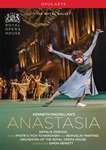|
Back
11/22/2017
Anastasia
Kenneth MacMillan (choreography), Piotr Il’yich Tchaikovsky, Bohuslav Martinů, Fritz Winckel, Rüdiger Rüfer (music), Bob Crowley (designer), John B. Read (lighting designer), Natalia Osipova (Anastasia/Anna Anderson), Christina Arestis (Tsarina Alexandra), Christopher Saunders (Tsar Nicholas), Thiago Soares (Rasputin), Marianela Nunez (Mathilde Kschessinska), Federico Bonelli (Her partner), Edward Watson (Officer, Anna’s husband), Orchestra of the Royal Opera House, Simon Hewett (conductor), Deborah MacMillan (production), Ross MacGibbon (screen director)
Recording: Royal Opera House, Covent Garden (November 2, 2016) – 113’ (+ bonus 14’)
Opus Arte OA 1243D (or Blu-ray OA BD7222D) – Booklet in English, French, and German (Distributed by Naxos of America)

   
Here is an intriguing opportunity to experience Kenneth MacMillan’s creation of a Russian ballet, much of it hearkening back to the era of Petipa. Adding further intrigue is that this ballet, set to the music of two Tchaikovsky symphonies and giving us an ahistorical version of the downfall of the Romanovs, is appended by an expressive, modernist act to the music of Bohuslav Martinů, depicting the anguished plight of the supposed daughter of Tsar Nicholas II, Anastasia (or Anna Anderson).
Act I, using Tchaikovsky’s Symphony N° 1, is set on the imperial yacht in 1914; 13-year-old Anastasia enters on roller skates. The action is reminiscent of the opening act of Sleeping Beauty, with an introduction to the royal household (in this case, the ultra-regal tsarina, the fatherly tsar, four princesses, and the fragile little tsarevich). There is much playful interaction with gallant crew members, and a glowering presence in the midst of it all by Rasputin. There are two dramatic moments: one when the tsarevich takes a tumble (Rasputin intervenes), and then a telegram announcing the outbreak of war. There is then a melancholy pas de deux for the tsar and tsarina (only Kenneth MacMillan would conceive such a thing.)
The second act (using Tchaikovsky’s Symphony N° 3 like that of Sleeping Beauty), takes us forward to another royal celebration. In this case three years have elapsed, and Anastasia is having her coming out ball. Here again is more scene-setting, with a gala appearance of prima ballerina assoluta Mathilde Kschessinska, the tsar’s former mistress. She and her gloriously handsome partner dance a brief scene in very grand imperial style, only to have her snubbed by the tsarina. The symphony’s scherzo is then employed to enact an awkward scene with the tsarina and Rasputin interacting with the tsar and Kschessinska. Again, Kenneth MacMillan is using traditional dance forms to express ambiguous or contradictory emotions.
There is then a brief scene showing downtrodden peasants and workers being given rifles. The ball scene resumes, but it is invaded by revolutionaries and the palace is set on fire.
The start of Act III, set in an insane asylum, is accompanied by harsh electronic sounds representing the voices in Anna Anderson’s head (or, perhaps, they are real?) We see newsreel footage of the imperial family (this comes across well on the Blu-ray) with an enactment of the imperial family’s execution. Anna veers back and forth between catatonia and frenzy as she deals with hospital staff, a group of tsarist socialites, and reappearances of her family and revolutionaries, all danced to Martinů’s Symphony N° 6. She has a sympathetic husband who attempts to sooth her torment. The revolutionaries shoot him. Upping the tension is the reappearance of Rasputin, whom she eventually vanquishes. At the end, though, isolated Anna is still in torment.
The work has an odd history, originating as a single-act work (now Act III) in 1967 for the ballet company of the Deutsche Oper Berlin. In 1971, for the Royal Ballet, the two first acts were added. The current production dates from 1996. Originating the title role was Lynn Seymour, arguably the greatest dramatic dancer of her era (active 1958-81) and recognized as MacMillan’s muse. The work stands or falls on the abilities of the Anastasia, and Natalia Osipova really triumphs, taking us from the tomboyish teen of Act I, to the elegant debutante in Act II and finally to the agitated madwoman in Act III.
Full-evening ballets of the core repertoire usually feature a couple: every princess is in need of a prince. In this case the male “lead” is her nemesis, Rasputin, performed by Thiago Soares. Costume and make-up do much to create the role, but when he gets a chance to dance, he instantly establishes his authority until Anna’s final rage surfaces, and he's finally kicked aside...it is quite the astonishing scene.
Christina Arestis is the epitome of regal grace and hauteur as the Tsarina Alexandra, while in Act II Marianela Nuñez creates balletic magic as Mathilde Kschessinska as does Federico Bonelli as her partner. The numerous smaller roles are all well performed, showing off the Royal Ballet’s depth of talent.
If the work has one big flaw, it derives from MacMillan’s use of three pre-existing works. The two Tchaikovsky symphonies have the right tone for the content, but the structure of each work means that the choreographer has to create movement to occupy too much time. The luxurious music seems destined for grand ballet, but the drama needs more conciseness. And then in the third act, the three-part Martinů symphony breaks the action that would best be continuous. One keeps expecting a new development in each section, but Anna’s anguished situation simply keeps repeating itself.
Michael Johnson
|